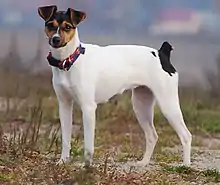| Brazilian Terrier | |||||||||||||||||||||||||||
|---|---|---|---|---|---|---|---|---|---|---|---|---|---|---|---|---|---|---|---|---|---|---|---|---|---|---|---|
 Brazilian Terrier | |||||||||||||||||||||||||||
| Other names | Fox Paulistinha Terrier Brasileiro | ||||||||||||||||||||||||||
| Origin | Brazil | ||||||||||||||||||||||||||
| |||||||||||||||||||||||||||
| |||||||||||||||||||||||||||
| Dog (domestic dog) | |||||||||||||||||||||||||||
The Brazilian Terrier is a breed of dog developed in Brazil. It is one of several terriers and one of the two worldwide recognized native breeds of Brazil.[2][3]
Description
Origin
One theory about the origin of the breed is that Jack Russell Terriers, Parson Russell Terriers and Fox Terriers were brought to Brazil from Europe in the 1800s and served as the nearest ancestor of the Brazilian Terrier.[4] Another theory is that the breed is derived from Spanish breeds such as the Ratonero Bodeguero Andaluz and Valencian Terrier brought to Brazil in vessels during the period of the Iberian Union.[5]
Appearance
This terrier stands between 13–16 in (35.5-40.5 cm) at the withers.[6] The breed generally weighs between 15-22 lbs (7–10 kg).[7] Its coat is short, sleek, and fine. The coloring is always tri-color (white, tan and black or white, tan and blue or white, tan and brown). A docked tail, narrow chest, flat triangular skull and a well balanced body are the most common characteristics. The ears are half-pricked and folded, with the tip falling down.
Temperament
The temperament of this breed is very similar to a Jack Russell Terrier, very alert, perky and intelligent. Very friendly, loves to play and dig holes. Spirited and obedient but fearless, as watchdogs they will only bark to get your attention and then leave the rest up to you. This breed needs fair and consistent training, otherwise, they can become destructive. Their hunting instinct is the strongest among average terriers and should not be trusted with other small animals.
Living conditions and exercise
Small apartments or spaces are not good for this breed of dog, because they are very active; an average-size yard is highly recommended. It also needs both physical and mental activities to be happy. A common tendency is for it to become destructive and restless if kept indoors; therefore, long daily walks are the best option.
See also
References
- ↑ FCI - Brazilian Terrier breed standard
- ↑ FCI - Terrier group
- ↑ FCI - Group 2 : Pinscher and Schnauzer - Molossoid and Swiss Mountain and Cattledogs. Section: 2 Molossian type - 2.1 Mastiff type
- ↑ AdoroCães.com.br Site - Terrier brasileiro (in Portuguese)
- ↑ AdoroCães.com.br Site - Terrier brasileiro (in Portuguese)
- ↑ The Dog Encyclopedia. London: DK Publishing. 2013. p. 210. ISBN 9781409364214. Retrieved 19 September 2014.
- ↑ The dog encyclopedia. Dennis-Bryan, Kim., Baggaley, Ann., John, Katie., DK Publishing, Inc. (First American ed.). New York. October 2013. ISBN 9781465421166. OCLC 859155647.
{{cite book}}: CS1 maint: location missing publisher (link) CS1 maint: others (link)